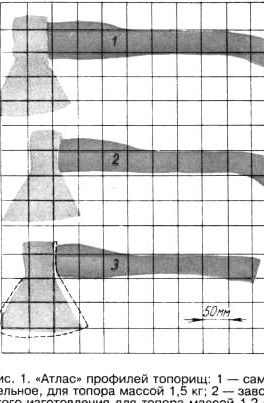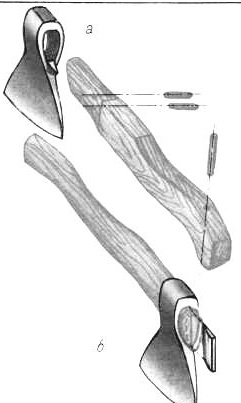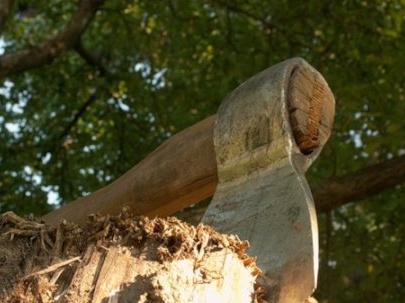The process of manufacturing an ax should actually begin even before acquiring an ax: it is necessary to acquire a high-quality birch board with a thickness of 35-40 mm, which must be carefully dried carefully. It is enough to have an ax weighing no more than 1.5 kg. I note that it can also happen that, having acquired a planted ax, you will feel that the ax is not enough. In this case, you can make the ax again, and on the freed to plant an ax with a mass of less.
The ax configuration should not be sought with excessive bending. The material for an ax of this kind should serve as a frizzy blank from a part of birch close to the rhizome. And since for you the ax, apparently, is not, so to speak, the main breadwinner, you can get by with a simpler configuration of the ax.
As a template, you can use the shape of your favorite hatchet (Fig. 1). It is best to cut the workpiece from the board with an electric jigsaw, while the allowance on the sides is very insignificant, since the cut cleanliness is extremely high, and the sawing accuracy too. The allowance at the front and rear ends must be more significant.

When roughing a workpiece, excess material along its edges can be removed on a circular saw. At the beginning of the processing, the nozzle of the ax is adjusted using a chisel, plane, bastard file and mallet, with which the workpiece is driven into the ax's eye (Fig. 2, a). The handle of the hatchet is processed after the preliminary nozzle of the ax and, as they say, along the arm. The tools are the same plus a sandpaper for grinding.

A cut is made in the front end part of the treated ax, which is slightly pierced with a chisel. Then the ax is finally planted, the protruding part of the ax is cut off with a bench saw and a pointed wedge made of steel 3 mm thick is hammered (Fig. 2.6). After the wedge enters the ax to the required depth, its protruding part is sawn off at a distance of about 5-6 mm from the end. I note that the protruding part of the wedge will not be a serious obstacle to the work, however, later, as the ax loosens, which can happen for various reasons, it will be possible to completely hammer the wedge, again clearly fixing the ax.
Only after that the end part of the handle is sawed off, and the surface of the ax is impregnated with linseed oil or coated with oil varnish. It should be noted that sometimes birch has an increased tendency to crack.When this property is discovered at the manufacturing stage close to the finish, hazardous areas near the rear end can be strengthened by drilling holes with a diameter of 8 mm in the direction perpendicular to the direction of the layers. In them, artificial knots are clogged with PVA glue - pins, which should be made from less hard wood.

